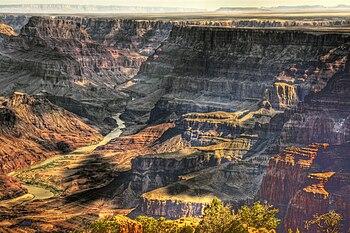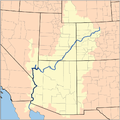Colorado River (U.S.): Difference between revisions
Pat Palmer (talk | contribs) (moving one image from the gallery to the top of the article) |
Pat Palmer (talk | contribs) mNo edit summary |
||
| Line 6: | Line 6: | ||
Large-scale river management began in the early 1900s. With all of its waters fully allocated, there is more demand for its waters than can be accommodated, resulting in extensive ongoing legal battles. In particular, the lower Colorado provides water to [[Las Vegas, Nevada|Las Vegas]], [[Los Angeles, California|Los Angeles]], [[San Diego, California|San Diego]], [[Phoenix, Arizona|Phoenix]], and [[Tucson, Arizona|Tucson]]. Upstream, the Colorado has been drastically depleted due to people are taking too much water out of the river basin and also due to drought exacerbated by climate change. The region the Colorado River flows through is the driest it has been in 1200 years. The use of water upstream and the accompanying reduction of freshwater flow has resulted in the loss of most of the wetlands in the Colorado River delta area in Mexico, causing drastic changes to the aquatic ecosystems there. | Large-scale river management began in the early 1900s. With all of its waters fully allocated, there is more demand for its waters than can be accommodated, resulting in extensive ongoing legal battles. In particular, the lower Colorado provides water to [[Las Vegas, Nevada|Las Vegas]], [[Los Angeles, California|Los Angeles]], [[San Diego, California|San Diego]], [[Phoenix, Arizona|Phoenix]], and [[Tucson, Arizona|Tucson]]. Upstream, the Colorado has been drastically depleted due to people are taking too much water out of the river basin and also due to drought exacerbated by climate change. The region the Colorado River flows through is the driest it has been in 1200 years. The use of water upstream and the accompanying reduction of freshwater flow has resulted in the loss of most of the wetlands in the Colorado River delta area in Mexico, causing drastic changes to the aquatic ecosystems there. | ||
In April 2023 as the river shrinks, the Biden administration prepared to impose | In April 2023 as the river shrinks, the Biden administration prepared to impose reductions in water supplies to states for the first time. The plan would cut the water delivered to California, Arizona and Nevada by as much as one-quarter, and the reduction would be divided evenly across all the states.<ref name=Restrictions2023 /> In May 2023, the administration announced that a deal had been reached for the immediate future on how to keep the river flowing.<ref name=2023DealTerms /><ref name=2023DealWapo /> Aided by a wet winter in 2022-2023 and $1.2 billion in federal payments, the new agreement expires at the end of 2026.<ref name=2023DealNYTimes /> | ||
== Gallery == | == Gallery == | ||
Revision as of 12:05, 23 May 2023
The Colorado River is a 1,450-mile-long river whose highly litigated waters are a lifeline in an arid region. The river starts in the Rocky Mountains of Colorado and flows southwest, then south, through Utah, Arizona, Nevada, California, and Mexico. Its headwaters begin at the continental divide in the center of Colorado, and its lowest part crosses Mexico between Baja and Sonora to flow into the Gulf of California. The river passes through 11 different national parks and monuments of varied landscapes, including the Grand Canyon and Hoover Dam.
Large-scale river management began in the early 1900s. With all of its waters fully allocated, there is more demand for its waters than can be accommodated, resulting in extensive ongoing legal battles. In particular, the lower Colorado provides water to Las Vegas, Los Angeles, San Diego, Phoenix, and Tucson. Upstream, the Colorado has been drastically depleted due to people are taking too much water out of the river basin and also due to drought exacerbated by climate change. The region the Colorado River flows through is the driest it has been in 1200 years. The use of water upstream and the accompanying reduction of freshwater flow has resulted in the loss of most of the wetlands in the Colorado River delta area in Mexico, causing drastic changes to the aquatic ecosystems there.
In April 2023 as the river shrinks, the Biden administration prepared to impose reductions in water supplies to states for the first time. The plan would cut the water delivered to California, Arizona and Nevada by as much as one-quarter, and the reduction would be divided evenly across all the states.[1] In May 2023, the administration announced that a deal had been reached for the immediate future on how to keep the river flowing.[2][3] Aided by a wet winter in 2022-2023 and $1.2 billion in federal payments, the new agreement expires at the end of 2026.[4]
Gallery
Notes
- ↑ White House Proposes Evenly Cutting Water Allotments From Colorado River 4-11-2023 at the New York Times.
- ↑ Final letter outlining the deal for Arizona, California, and Nevada and other parties on the U. S. Department of Interior website. Last access 5/23/2023.
- ↑ States reach deal with Biden to protect drought-stricken Colorado River by Joshua Partlow at the Washington Post website. Last access 5/23/2023.
- ↑ A Breakthrough Deal to Keep the Colorado River From Going Dry, for Now by Christopher Flavell at the New York Times website. Last access 5/23/2023.




